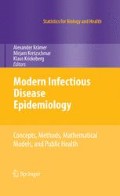Abstract
Over the last century, infectious diseases have lost a lot of their threat to individuals’ health as well as to the health of populations living in industrialized countries. The continuous reduction and effective control of both mortality and morbidity from infectious diseases marks an impressive story of success in the history of public health in the developed world and has been linked to a wide range of improvements that occurred alongside the socioeconomic modernization of these societies. Although many factors (e.g., improved sanitation, development of antibiotics and vaccines, improved living conditions and food quality/availability, and improved health care and surveillance systems) that contributed significantly to the success have been identified, there are, however, still uncertainties about the underlying mechanisms and interactions that led to the decline of infectious disease mortality
Access this chapter
Tax calculation will be finalised at checkout
Purchases are for personal use only
References
Anand S, Hanson K (1997) Disability-adjusted life years: a critical review. J Health Econ 16(6):685–702
Atkinson RL, Dhurandhar NV, Allison DB, Bowen RL, Israel BA, Albu JB, Augustus AS (2005) Human adenovirus-36 is associated with increased body weight and paradoxical reduction of serum lipids. Int J Obes (Lond) 29:281–286
Carbone KM, Luftig RB, Buckley MR (2005) Microbial triggers of chronic human illness. American Academy of Microbiology, Washington
Lopez AD, Mathers CD, Ezzati M, Jamison DT, Murray CJL (eds) (2006) Global burden of disease and risk factors. Oxford University Press, New York
Mathers CD, Loncar D (2006) Projections of global mortality and burden of disease from 2002 to 2030. PLoS Med 3(11): e 442
Mathers CD, Lopez AD, Murray CJL (2006) The burden of disease and mortality by condition: data, methods, and results for 2001. In : Lopez AD, Mathers CD, Ezzati M, Jamison DT, Murray CJL (eds) Global burden of disease and risk factors. Oxford University Press, New York, pp 45–93
Mathers CD, Vos T, Lopez AD, Salomon J, Ezzati M (eds) (2001) National burden of disease studies: A practical guide. Edition 2.0. World Health Organization, Geneva
Murray CJL (1994) Quantifying the burden of disease: the technical basis for disability-adjusted life years. Bull World Health Organ 72(3):429–445
Murray CJL (1996) Rethinking DALYs. In: Murray CJL, Lopez AD (eds.) The Global Burden of Disease: a comprehensive assessment of mortality and disability from diseases, injuries, and risk factors in 1990 and projected to 2020. Harvard University Press, Cambridge, pp 1–98
Murray CJL, Lopez AD (eds.) (1996) The Global Burden of Disease: a comprehensive assessment of mortality and disability from diseases, injuries, and risk factors in 1990 and projected to 2020. Harvard University Press, Cambridge
Murray CJL, Lopez AD (1997a) Mortality by cause for eight regions of the world: Global Burden of Disease Study. Lancet 349(9061):1269–1276
Murray CJ, Lopez AD (1997b) Alternative projections of mortality and disability by cause 1990-2020: Global Burden of Disease Study. Lancet 349(9064):1498–1504
Olshansky SJ, Ault AB (1986) The fourth stage of the epidemiologic transition: the age of delayed degenerative diseases. Milbank Q 64(3):355–391
Omran AR (1971) The epidemiologic transition. A theory of the epidemiology of population change. Milbank Mem Fund Q 49(4):509–538
Sagan LA (1987) The health of nations:True causes of sickness and well-being. Basic Books, New York
UNAIDS (2007) AIDS epidemic update: December 2007. World Health Organization, Geneva
World Bank (2002) World Development Report 2003: sustainable development in a dynamic world: transforming institutions, growth, and quality of life. Oxford University Press, New York
World Health Organization (2002) The world health report 2002 - reducing risks, promoting healthy life. World Health Organization, Geneva
Author information
Authors and Affiliations
Corresponding author
Editor information
Editors and Affiliations
Rights and permissions
Copyright information
© 2009 Springer Science+Business Media, LLC
About this chapter
Cite this chapter
Pinheiro, P., Mathers, C.D., Krämer, A. (2009). The Global Burden of Infectious Diseases. In: Krämer, A., Kretzschmar, M., Krickeberg, K. (eds) Modern Infectious Disease Epidemiology. Statistics for Biology and Health. Springer, New York, NY. https://doi.org/10.1007/978-0-387-93835-6_1
Download citation
DOI: https://doi.org/10.1007/978-0-387-93835-6_1
Published:
Publisher Name: Springer, New York, NY
Print ISBN: 978-0-387-93834-9
Online ISBN: 978-0-387-93835-6
eBook Packages: Mathematics and StatisticsMathematics and Statistics (R0)

